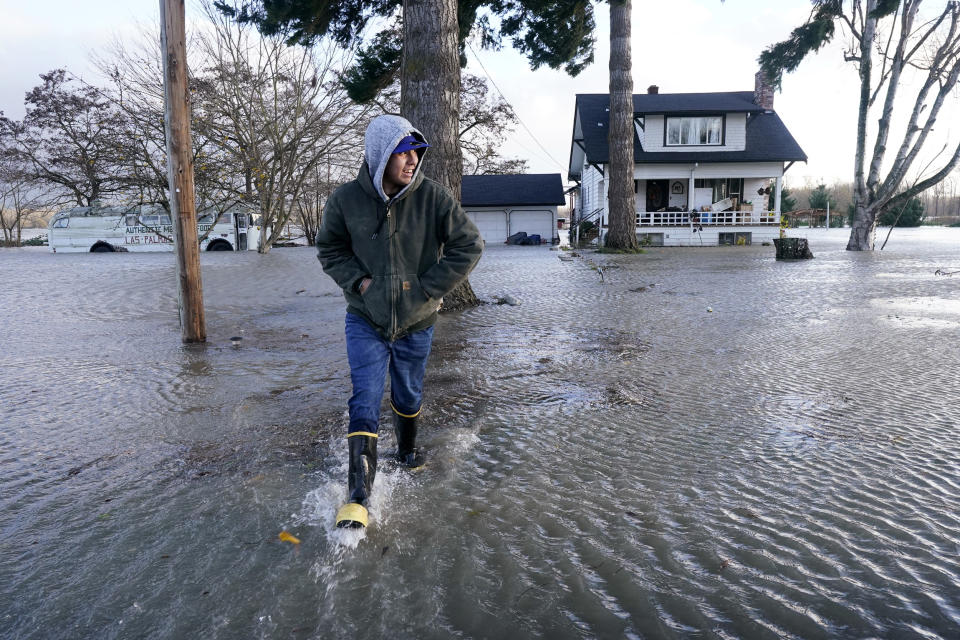Floodwaters rush through several Pacific Northwest towns amid record rainfall
SEATTLE — Floodwaters in the Pacific Northwest have inundated homes, forced rescues and shuttered schools as a trio of deluges set rainfall records.
Swollen rivers began to crest at record highs Monday. Photos showed downtown Sumas, Washington, a town along the Canadian border, inundated. Cars were stuck in the streets of Bellingham, Washington, city officials said. Two nearby landslides — most likely resulting from saturated soils — sent debris onto Interstate 5, forcing part of the state’s most important roadway to close overnight. Winds gusted at nearly 60 mph at Seattle-Tacoma International Airport on Monday, according to the National Weather Service.
The severe weather led Washington Gov. Jay Inslee to issue an emergency proclamation for some areas, freeing up state resources to assist hard-hit areas.
About 70,000 utility customers in Washington were without power early Tuesday, according to PowerOutage.Us, which tracks outages nationwide.
To the north, the Canadian province of British Columbia faced flooding and winds said to be strong enough to cause power outages and fell trees, officials said.
The provincial government said flooding and mudslides stranded motorists, many of whom were the subject of search-and-rescue operations into the night Monday. Local communities were helping to house those rescued, the government said.
"As of Monday afternoon, many people have been airlifted from mudslides near Agassiz and Lillooett and been relocated to safe locations," the B.C. government tweeted.
East of Vancouver, fire services rescued 275 people that were trapped between two mudslides on Highway 7.
In Vancouver a barge broke loose and struck a seawall in English Bay, prompting someone to give it a parody Twitter account. Vancouver Island’s Highway 1 was also flooded, officials said.
Authorities on the Canadian side of the Sumas Prairie area warned residents to be prepared to evacuate Monday night in the midst of rising floodwaters.
In parts of Abbotsford, a city on the border east of Vancouver, officials ordered evacuations under a local state of emergency.
An atmospheric river — a plume of moisture that stretches across the Pacific and near Hawaii — has been aimed toward the region since last week, said Joe Boomgard-Zagrodnik, an agricultural meteorologist at Washington State University.
Beginning Thursday, a trio of storms tapped into that moisture and hammered areas north of Seattle and on Washington’s Olympic Peninsula with driving rainfall.
Atmospheric river patterns are not uncommon in the region, but the barrage of storms comes during a historically wet fall. And the flooding strikes a region that suffered a heat wave that set records in June, became smothered with wildfire smoke in August and remained abnormally dry for much of summer.
“We were super hot and dry in the summer, and the switch flips. It definitely matches what the climate models show for the future around here — hotter, dryer summers and wetter winters,” Boomgard-Zagrodnik said. “Our infrastructure isn’t designed for that.”

Floodwaters rushed through several Northwest towns, including Hamilton, Washington, along the Skagit River about 65 miles northeast of Seattle.
“It’s 100 percent flooded,” Mayor Carla Vandiver said of the town core. Vandiver traveled through the streets of the 300-person town Monday morning by boat, capturing the scene on her cellphone.
In one of the videos, rain pattered as Vandiver traveled past half-submerged stop signs and debris floated past the boat. She found most every home, recreational vehicle and businesses half-submerged, including her own garage, which was under about 6 feet of water.
Vandiver said that most everyone fled Hamilton over the weekend and that she had yet to hear of any rescues.
“Everybody knew this was coming,” Vandiver said. After flood predictions, fire officials knocked door to door to warn of flooding and set off the town’s flood sirens.
A Red Cross shelter at Hamilton First Baptist Church was “bursting at the seams,” Vandiver said. The church and the shelter did not have power Monday afternoon.
“That’s our first priority, to get our power back on,” said Pastor Ron Edwards, who expected to shelter and serve meals to people for several days.
Hamilton has flooded for centuries, but local climate scientists expect the risk to increase as the climate warms.
Forterra, a Seattle-based nonprofit group, is helping lead efforts to expand the town and give residents the option to move to higher ground. The project has not broken ground yet.
Vandiver said that the cost of the flooding will be severe but that Hamilton has rebuilt before.
“It breaks my heart. People live in Hamilton because they’re not wealthy. It’s cheaper to live out here,” Vandiver said. “A majority of these people are going to be in trouble when it comes time to clean up.”
The impacts of the flooding were widespread and significant.
The Coast Guard on Monday evacuated 10 people from residential flooding just west of Forks on Washington’s Olympic Peninsula.
The Whatcom County Sheriff’s Office, which covers territory directly north of Seattle, had to help evacuate stranded residents in Everson, near the Canadian border. Images shared by the sheriff’s office showed vehicles submerged up to their headlights in muddy water.
At least four rivers in northwest Washington reached record levels of flooding, according to the National Weather Service. Wind gusts exceeding 60 mph were recorded throughout the region.
The Bellingham School District, which serves about 12,000 students, canceled classes Monday because too many areas nearby were impassable or dangerous.
Closings dotted roadways throughout Western Washington because of downed trees, standing water or landslides, said Alexa Fortuna of the state Transportation Department. Winds tipped a semi-truck against a guardrail on the 180-foot-high bridge that spans Deception Pass, the gap between two islands. A gust of wind of about 65 mph was reported nearby, said Trooper Rocky Oliphant of the Washington State Patrol.

With so much ground saturated, the risk of landslides will remain elevated for several days, said Kirby Cook, a National Weather Service meteorologist based in Seattle.
Rainfall slowed Monday afternoon as a cold front pushed through the region, accompanied by strong winds.
Even for the Pacific Northwest, a region known for gloom and drizzle, the rain has been unrelenting.
“Seattle has not seen more than two days of dry weather since late September,” Boomgard-Zagrodnik said, adding that most of Western Washington and Oregon have had 1½ to 2 times the typical rainfall for the season.
As of Sunday, Seattle-Tacoma International Airport had gotten more than 15 inches of rain during the meteorological fall and was on pace to set a record for seasonal rainfall, Boomgard-Zagrodnik said.
“We’re starting to see what is becoming the new reality,” he said.

